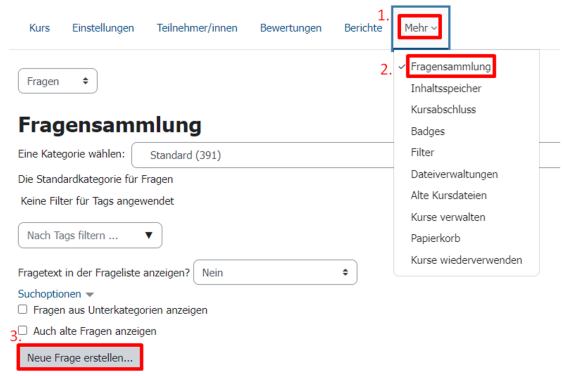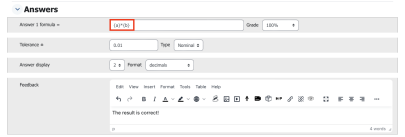Question Type 'Simple Calculated Questions'
This question type allows you to create mathematical problems where the numerical values vary each time the question is presented.
Create a question
To create a new question, you can find your “Question Bank” in your course by selecting the “More” tab in the top navigation bar. Within the “Question Bank”, you can edit your question bank and click on “Create a new question…” to add new questions.
Now, you can choose the respective question type from the menu.
We will select “Simple Calculated”.
When creating the question, there are some important settings to configure:
First, you need to specify a question name, question text, and the points available. Within the General Feedback text box, you can design feedback that will be displayed after the question is answered, regardless of how the question was answered.
The unique feature of this question type becomes apparent in the question text. Here, so-called “wildcards” can be used to represent values as variables. These wildcards are written in curly braces. In this example, the question text is: “What is the area in m² of a rectangle with sides {a} m and {b} m?”. The variables a and b can take different values each time the question is presented.
Create answer
In the answer box, you enter your answer formula (calculation method) that yields the correct result. Additionally, you can set a grade for the answer, specify a tolerance (relative or nominal), and define the accuracy format for the answer. In the feedback block, you can enter a feedback text that will only be displayed if the question is answered with this specific answer.
Note: Do not use an equal sign within the answer formula.
In the sections “Unit handling” and “Units”, you can configure various settings related to the (measurement) unit of the answer. You can choose whether units should be considered during grading and, if so, how much to deduct for using the wrong unit or no unit at all. Additionally, you can add extra units that can be converted into the default unit with the appropriate conversion factor in the “Units” section.
Note: When entering the factor, use a period (.) instead of a comma (,).
The next important step is to configure settings for the variables (wildcards) used. To do this, click the button “Find wildcards {x..} present in correct answer formulas”. A new section titled “Wildcard parameters used to generate the values” will then appear. In this section, you can define the range of values and the number of decimal places for the relevant wildcards. Just below this section, you have the option to create a specific dataset that represents the different “versions” of the question. By clicking the “Generate” button, you create a dataset with the corresponding number of values. You can then view a selection of these values under the “Wildcard values” section by clicking the “Display” button. Additionally, under “Wildcard values”, you can click “Show more” to individually adjust the data if desired.







